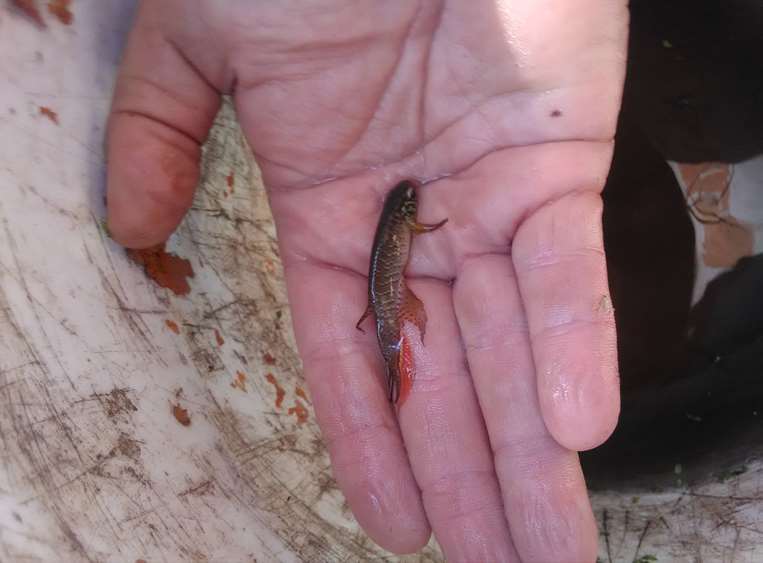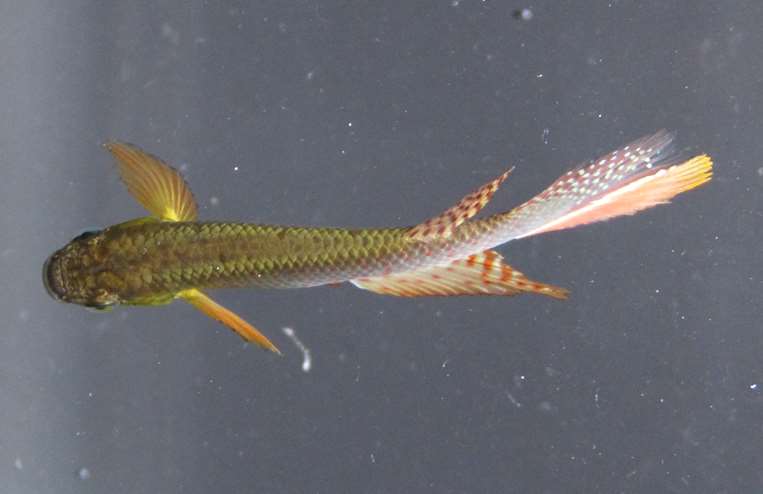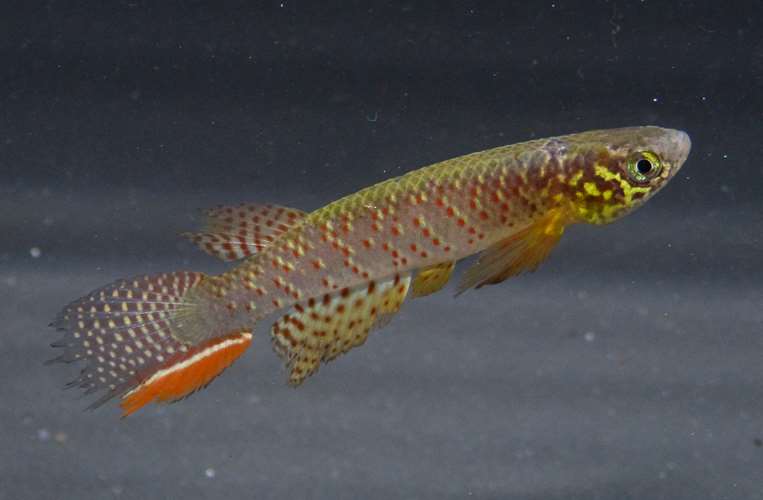July 15, 2023, 5:52 PM
July 15, 2023, 5:52 PM
Moema juanderibaensis is the species of fish, of the rivulid family (Rivulidae), discovered in Santa Cruz by the biologist Heinz Arno Drawert, who is a research associate at Noel Kempff Mercado Natural History Museum. This fish has a very special characteristic: can breathe out of water for three continuous hours, before returning to the water to feed or cool off. Their lifestyle is amphibious. This species is endemic to Santa Cruz.
The fish, which was found in Santa Rosa del Sara by Drawet, years ago, caught his attention, because it was not a type of fish he had seen before, since he has been passionate about fish since he was eight years old.
Since he first recorded the Moema juanderibaensis, he began to search for information about this fish, but found nothing in the books. However, it took several years before he was finally able to formally research and study it.
Thus he established that Moema juanderibaensis measures between four and five centimeters; the males are larger than the females, and also more showy.
These fish have a greyish-green body background, with blue, light blue, red or orange dots, resembling transversal lines. They have enlarged, stretched and showy fins; Also in the tail they have what they call a sword, an elongated fin that stands out for its color, which can be red or yellow. Meanwhile, the fins are golden, Drawert describes.
He remembers that it was in 2018 when he was invited to be an associate researcher at the Natural History Museum, an opportunity in which he could study, with all the scientific seriousness that corresponds, the fish that had caught his attention years ago. So he started the paperwork, he prepared the research project that was to be approved not only by the Museum, but also by the Ministry of the Environment; letters were sent to request permits, and time began to pass. At the end of 2019, his project was approved.
The Moema is a very restless fish, which jumps a lot and is very territorial. Drawert recounts that when he studied them in a fish tank -after having collected them in Santa Rosa, where he had initially sighted them- he observed that the fish would come out of this container. For this reason, the water level lowered, but later he found them stuck to the glass. At first he put them back in the water, but then he realized that they left voluntarily and that they were also located on the floating plants of the fish tank, out of the water. Drawert continued digging and found that there was information on amphibian ruffled; the information was scarce and only referred to a genus found in Central America and the Caribbean.

The biologist explains that these fish change the way they breathe; dthey stop doing it through the gills, which close; that is to say that the fish change their morphology, and begin to breathe through the skin, as amphibians do: frogs, toads and salamanders. Thus they have an adaptation to survive out of water. Of course, they need good humidity in the environment so that their skin does not dry out. Normal fish, after a few minutes out of the water, experience dry gills, which for them has a fatal outcome.
In 2020, the Covid-19 pandemic and its restrictions cut short many plans, including Drawert’s field work, which he had to study adult individuals, those that are only found in the rainy seasonwhich means between January and April, maximum May of each year.

But 2020 was not a lost year. Like Drawert, many researchers and scientists around the world were without access to their laboratories and their ‘normal’ occupations, so that time was used to Connect with your peers around the worldor, to get more information, learn to photograph live and moving fish… and do all the desk work. The pandemic gave birth to a network of collaborative work of scientists from different countries, both South American and European, all of them with the support of scientific institutions, such as the Museum of Natural History in Bolivia and the Kilifish Foundation in Argentina. This allowed not only the exchange of information and data, but the creation of joint projects.
2021 arrived and Drawert collected the samples in Santa Rosa. He tells that he was looking to do something different, to go beyond classical research, and he proposed to make a description from living specimens. This allowed him to see that they are active fish, with an accelerated metabolism, intense interaction and that they are territorial. They grow rapidly and reach sexual maturity at three weeks of age, when they reproduce.

One of the findings on the rivulids, to which belongs the Moema, is that these fish lay their eggs and bury them. The puddle or curichi in which they live can dry up, but the eggs remain dormant -up to three years, according to scientific verifications, and four, according to recent investigations. These eggs can survive periods of drought. Fish adults may disappear, but their eggs remain in a state of dormancy, and after they hatch, the cycle begins once more.
It takes a good rain for the eggs to “decide” to hatch. Scientific studies found that if the eggs are eaten by birds, these survive in the digestive tract of birdswhich become a “transport” of these eggs.
Drawert explains that buried eggs don’t necessarily hatch when it rains, but when they do, they appear in the next two to five days. They develop rapidly, so much so that They double in size from one day to the next. and, at three weeks, they reach sexual maturity. They have a short life; In nature They live between two and five months.. In an aquarium, with a controlled diet, lowering the temperature, they manage to live a little over a year. However, at the end of that time they “turn off”, Drawert describes, they stop moving and eating, until they die.
Once the field work was done, a scientific article had to be written with the description of the species, and so it happened. Before being published, the article must be reviewed and approved. Other scientists do a thorough review of the article before giving it the go-ahead, and that takes months. Finally, in November 2022 the publication came out and with it the description of the Moema for science. scientific journal Neotropical Ichthyology published Drawert’s research in 2022.
The scientist continues his investigative work and studies the family rivulidae in Bolivia. The objective is to identify the distribution in the country and have a baseline of the species that inhabit this territory.
















